Showing Spotlights 1737 - 1744 of 2780 in category All (newest first):
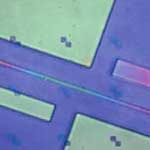 Dip-Pen Nanolithography (DPN) is a scanning probe lithography technique in which the tip of an atomic force microscope (AFM) is used to deliver molecules to a surface, allowing nanostructured surface patterning on scales of under 100 nm. This direct-write technique offers high-resolution patterning capabilities for a number of molecular and biomolecular 'inks' on a variety of substrates, such as metals, semiconductors, and monolayer functionalized surfaces. It's becoming a work-horse tool for the scientist interested in fabricating and studying soft- and hard-matter on the sub-100nm length scale.
Using DPN for fabricating graphene devices has not been previously shown. Researchers at Stanford University have now evaluated DPN as an alternative to conventional electron-beam lithography (EBL) for tailoring such devices.
Dip-Pen Nanolithography (DPN) is a scanning probe lithography technique in which the tip of an atomic force microscope (AFM) is used to deliver molecules to a surface, allowing nanostructured surface patterning on scales of under 100 nm. This direct-write technique offers high-resolution patterning capabilities for a number of molecular and biomolecular 'inks' on a variety of substrates, such as metals, semiconductors, and monolayer functionalized surfaces. It's becoming a work-horse tool for the scientist interested in fabricating and studying soft- and hard-matter on the sub-100nm length scale.
Using DPN for fabricating graphene devices has not been previously shown. Researchers at Stanford University have now evaluated DPN as an alternative to conventional electron-beam lithography (EBL) for tailoring such devices.
Dec 3rd, 2010
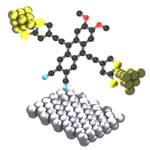 For the visionary goals of nanotechnology, functional and perhaps autonomous molecular motors will play an essential part, just like electric motors can be found in many appliances today. These nanomachines could perform functions similar to the biological molecular motors found in living cells, things like transporting and assembling molecules, or facilitating chemical reactions by pumping protons through membranes. Although applications of molecular motors are still in the future, the results of early-day studies are already spectacular: well-designed molecules or supramolecules show different kinds of motion - fueled by different driving forces such as light, heat, or chemical reactions - resulting in molecular shuttles, molecular elevators and rotating motors. A team of researchers is now proposing a conceptually new design of molecular motor based on electric field actuation and electric current detection of the rotational motion of a molecular dipole embedded in a three-terminal single-molecule device.
For the visionary goals of nanotechnology, functional and perhaps autonomous molecular motors will play an essential part, just like electric motors can be found in many appliances today. These nanomachines could perform functions similar to the biological molecular motors found in living cells, things like transporting and assembling molecules, or facilitating chemical reactions by pumping protons through membranes. Although applications of molecular motors are still in the future, the results of early-day studies are already spectacular: well-designed molecules or supramolecules show different kinds of motion - fueled by different driving forces such as light, heat, or chemical reactions - resulting in molecular shuttles, molecular elevators and rotating motors. A team of researchers is now proposing a conceptually new design of molecular motor based on electric field actuation and electric current detection of the rotational motion of a molecular dipole embedded in a three-terminal single-molecule device.
Dec 2nd, 2010
 Global warming, caused by a build-up of greenhouse gases, in particular carbon dioxide, in the atmosphere, has led to numerous proposals on how to capture and store CO2 in order to mitigate the damaging emissions from fossil fuels. Today we take a look at carbon sequestration and subsequent storage in geological formations (geosequestration) - a proposal that is already being tested on a large scale. The idea behind coal-bed geosequestration is that you inject a huge amount of carbon dioxide into deep unmined coal seams. Due to strong adsorption forces, the carbon dioxide will be adsorbed in coal. It will not be desorbed and gradually transform to solid rocks. Moreover the technology is already developed and in use for oil and gas mining. However, the fundamental problem is so-called adsorption-induced deformation of coal or any other porous material.
Global warming, caused by a build-up of greenhouse gases, in particular carbon dioxide, in the atmosphere, has led to numerous proposals on how to capture and store CO2 in order to mitigate the damaging emissions from fossil fuels. Today we take a look at carbon sequestration and subsequent storage in geological formations (geosequestration) - a proposal that is already being tested on a large scale. The idea behind coal-bed geosequestration is that you inject a huge amount of carbon dioxide into deep unmined coal seams. Due to strong adsorption forces, the carbon dioxide will be adsorbed in coal. It will not be desorbed and gradually transform to solid rocks. Moreover the technology is already developed and in use for oil and gas mining. However, the fundamental problem is so-called adsorption-induced deformation of coal or any other porous material.
Nov 30th, 2010
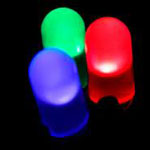 One of the many fascinating concepts in nanotechnology is the vision of molecular electronics where researchers are investigating nanostructured materials to build electronics from individual molecules. If realized, the shift in size from even the most densely packed computer chip today would be staggering. Molecular electronics aims at the fundamental understanding of charge transport through molecules and is motivated by the vision of molecular circuits to enable miniscule, powerful and energy efficient computers. A research team in Germany has now demonstrated that rigidly wired molecules can emit light under voltage bias. This result is important for fundamental science but it also adds to the molecular electronics vision an optoelectronic component, i.e. the development of optoelectronic components on the basis of single molecules.
One of the many fascinating concepts in nanotechnology is the vision of molecular electronics where researchers are investigating nanostructured materials to build electronics from individual molecules. If realized, the shift in size from even the most densely packed computer chip today would be staggering. Molecular electronics aims at the fundamental understanding of charge transport through molecules and is motivated by the vision of molecular circuits to enable miniscule, powerful and energy efficient computers. A research team in Germany has now demonstrated that rigidly wired molecules can emit light under voltage bias. This result is important for fundamental science but it also adds to the molecular electronics vision an optoelectronic component, i.e. the development of optoelectronic components on the basis of single molecules.
Nov 29th, 2010
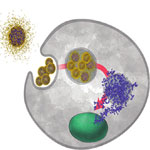 Scientists have shown that two pH response moieties - a pH solubility switch and a pH labile group - can be incorporated into the backbone of polymers which can then be formulated into dual responsive nanoparticles encapsulating small hydrophobic molecules and larger protein payloads. As nanoparticles they function akin to an AND logic gate. The beta-aminoester backbone moiety provides a pH triggered solubility switch, only when this switch is 'ON' does the ketal moiety also turn 'ON' to undergo rapid acid catalyzed hydrolysis. This system seems to be a promising vehicle for the administration of hydrophilic and hydrophobic payloads into target areas of the human body.
Scientists have shown that two pH response moieties - a pH solubility switch and a pH labile group - can be incorporated into the backbone of polymers which can then be formulated into dual responsive nanoparticles encapsulating small hydrophobic molecules and larger protein payloads. As nanoparticles they function akin to an AND logic gate. The beta-aminoester backbone moiety provides a pH triggered solubility switch, only when this switch is 'ON' does the ketal moiety also turn 'ON' to undergo rapid acid catalyzed hydrolysis. This system seems to be a promising vehicle for the administration of hydrophilic and hydrophobic payloads into target areas of the human body.
Nov 24th, 2010
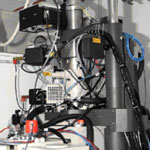 The workhorse of current nanofabrication processes, electron beam lithography (EBL), has good resolution but has good resolution, it is difficult to precisely control the pattern size at the sub-20 nm scale due to the proximity effect and the large beam spot. A more recent nanolithographic strategy, the molecular ruler (MR) method, shows great promise it can precisely control the size of the gap at the nanoscale. Although EBL and MR have been combined before in attempting high-resolution nanofabrication in the sub-20nm regime, the results were always less than optimal because the electron beam irradiation damage to the MR influenced the formation of nanogaps. Researchers in Japan have now developed a post-EBL process, which does not damage MR molecular layers, and fabricated nanogap structures at the expected positions with high product yield.
The workhorse of current nanofabrication processes, electron beam lithography (EBL), has good resolution but has good resolution, it is difficult to precisely control the pattern size at the sub-20 nm scale due to the proximity effect and the large beam spot. A more recent nanolithographic strategy, the molecular ruler (MR) method, shows great promise it can precisely control the size of the gap at the nanoscale. Although EBL and MR have been combined before in attempting high-resolution nanofabrication in the sub-20nm regime, the results were always less than optimal because the electron beam irradiation damage to the MR influenced the formation of nanogaps. Researchers in Japan have now developed a post-EBL process, which does not damage MR molecular layers, and fabricated nanogap structures at the expected positions with high product yield.
Nov 22nd, 2010
 Friends of the Earth have just published a new report titled 'Nanotechnology, climate and energy: over-heated promises and hot air?' As usual, the 'good cop, bad cop' team that writes this kind of document was at its best again. On one hand, there is a lot of really good information in this report, well researched and referenced, and it provides a very useful overview of what's going on in nanotechnology research and development in the climate/renewables fields - albeit with a very negative spin on it. On the other hand, there seems to be a monkey sitting on each FoE editor's shoulder that constantly whispers 'Are you kidding me? Boooring! Too positive! Too balanced! Not scary enough! Traitor - think of all the drowning polar bears!' We look at some of the misconceptions in FoE's report.
Friends of the Earth have just published a new report titled 'Nanotechnology, climate and energy: over-heated promises and hot air?' As usual, the 'good cop, bad cop' team that writes this kind of document was at its best again. On one hand, there is a lot of really good information in this report, well researched and referenced, and it provides a very useful overview of what's going on in nanotechnology research and development in the climate/renewables fields - albeit with a very negative spin on it. On the other hand, there seems to be a monkey sitting on each FoE editor's shoulder that constantly whispers 'Are you kidding me? Boooring! Too positive! Too balanced! Not scary enough! Traitor - think of all the drowning polar bears!' We look at some of the misconceptions in FoE's report.
Nov 18th, 2010
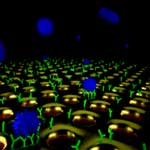 A multi-disciplinary research team has introduced a novel label-free optofluidic-nanoplasmonic biosensor and demonstrated direct detection of live viruses from biological media at medically relevant concentrations with little to no sample preparation. This novel platform can be easily adapted for point-of-care diagnostics to detect a broad range of viral pathogens in resource-limited clinical settings at the far corners of the world, in defense and homeland security applications as well as in civilian settings such as airports or other public spaces. This work is the first demonstration of detection of intact viruses using extraordinary light transmission phenomena in plasmonic nanohole arrays.
A multi-disciplinary research team has introduced a novel label-free optofluidic-nanoplasmonic biosensor and demonstrated direct detection of live viruses from biological media at medically relevant concentrations with little to no sample preparation. This novel platform can be easily adapted for point-of-care diagnostics to detect a broad range of viral pathogens in resource-limited clinical settings at the far corners of the world, in defense and homeland security applications as well as in civilian settings such as airports or other public spaces. This work is the first demonstration of detection of intact viruses using extraordinary light transmission phenomena in plasmonic nanohole arrays.
Nov 17th, 2010
 Dip-Pen Nanolithography (DPN) is a scanning probe lithography technique in which the tip of an atomic force microscope (AFM) is used to deliver molecules to a surface, allowing nanostructured surface patterning on scales of under 100 nm. This direct-write technique offers high-resolution patterning capabilities for a number of molecular and biomolecular 'inks' on a variety of substrates, such as metals, semiconductors, and monolayer functionalized surfaces. It's becoming a work-horse tool for the scientist interested in fabricating and studying soft- and hard-matter on the sub-100nm length scale.
Using DPN for fabricating graphene devices has not been previously shown. Researchers at Stanford University have now evaluated DPN as an alternative to conventional electron-beam lithography (EBL) for tailoring such devices.
Dip-Pen Nanolithography (DPN) is a scanning probe lithography technique in which the tip of an atomic force microscope (AFM) is used to deliver molecules to a surface, allowing nanostructured surface patterning on scales of under 100 nm. This direct-write technique offers high-resolution patterning capabilities for a number of molecular and biomolecular 'inks' on a variety of substrates, such as metals, semiconductors, and monolayer functionalized surfaces. It's becoming a work-horse tool for the scientist interested in fabricating and studying soft- and hard-matter on the sub-100nm length scale.
Using DPN for fabricating graphene devices has not been previously shown. Researchers at Stanford University have now evaluated DPN as an alternative to conventional electron-beam lithography (EBL) for tailoring such devices.
 Subscribe to our Nanotechnology Spotlight feed
Subscribe to our Nanotechnology Spotlight feed





